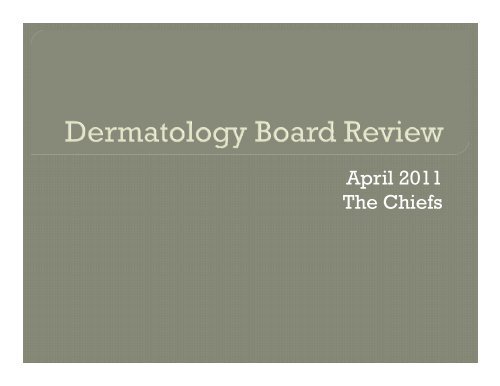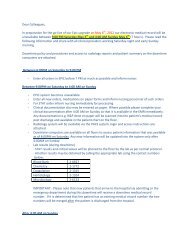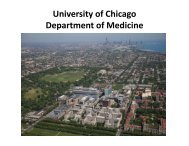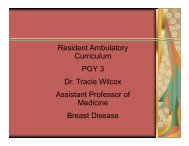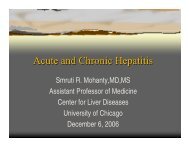Derm Board Review - The University of Chicago Department of ...
Derm Board Review - The University of Chicago Department of ...
Derm Board Review - The University of Chicago Department of ...
You also want an ePaper? Increase the reach of your titles
YUMPU automatically turns print PDFs into web optimized ePapers that Google loves.
April 2011<br />
<strong>The</strong> Chiefs
A 39-year-old y man is evaluated for a 3-day y history y <strong>of</strong> stinging g g<br />
lesions on his shins. He also notes joint pain and some numbness<br />
and tingling in his feet. He has a history <strong>of</strong> hepatitis C infection<br />
that has not required antiviral treatment.<br />
On physical examination, vital signs are normal. Skin examination<br />
discloses 2- to 3-mm, purple, palpable, nonblanching papules on<br />
the dorsal feet, shins, and buttocks. <strong>The</strong>re is no evidence <strong>of</strong><br />
synovitis. iti Laboratory L b t studies t di reveal l a normal l serum creatinine ti i<br />
level, modestly elevated levels <strong>of</strong> serum alanine and aspartate<br />
aminotransferases, low complement levels, and circulating<br />
cryoglobulins cryoglobulins. Skin biopsy shows leukocytoclastic vasculitis vasculitis.
Which Which <strong>of</strong> the following is the most<br />
appropriate treatment?<br />
A A. Pegylated interferon alfa and ribavirin<br />
B. Plasma exchange<br />
C C. Systemic corticosteroids<br />
D. Topical corticosteroids
Which Which <strong>of</strong> the following is the most<br />
appropriate treatment?<br />
A A. Pegylated interferon alfa and ribavirin<br />
B. Plasma exchange<br />
C C. Systemic corticosteroids<br />
D. Topical corticosteroids
Most Most consistent with mixed<br />
cryoglobulinemia associated with<br />
hepatitis C
Biopsy: leukocytoclastic vasculitis
Mixed Cryoglobulinemia<br />
Present in up to 50% <strong>of</strong> patients infected<br />
with hepatitis p C<br />
Symptomatic in less than 15% <strong>of</strong> infected<br />
patients<br />
All patients with Cryoglobulins should be<br />
checked for hepatitis C<br />
Associated A i t d signs/symptoms: i / t weakness, k<br />
arthralgia, peripheral neuropathy, and<br />
glomerulonephritis
Indications include: progressive systemic<br />
disease affecting small blood vessels<br />
• Organ dysfunction or cutaneous vasculitis<br />
First line therapy is treatment <strong>of</strong> the underlying<br />
Hepatitis C infection with pegylated interferon<br />
and ribavarin<br />
<strong>The</strong>oretical concern that steroids will lead to<br />
iincreased d viral i l replication li ti<br />
Plasma exchange only for very advanced<br />
disease-such disease such as limb threatening or advanced<br />
renal failure
More easily palpated then visualized
Half Half are idiopathic<br />
Associated with<br />
• Infections<br />
• Drugs<br />
• Inflammatory systemic disease
http://www.flickr.com/photos/35230739@N05/3315480015,<br />
http://www.afv.org.hk/uveitis_e.htm
Erythema Erythema nodosum<br />
Hilar lymphadenopathy<br />
Lower Lower extremity arthritis<br />
Anterior uveitis<br />
Acute self resolving subset <strong>of</strong><br />
sarcoidosis
E Nodosum parallels activity <strong>of</strong> GI<br />
E. Nodosum parallels activity <strong>of</strong> GI<br />
disease
A A 62-year-old 62 year old man is evaluated for an<br />
asymptomatic nodule on his shoulder<br />
that has been present for more than 1<br />
year.
Which Which <strong>of</strong> the following is the most likely<br />
diagnosis?<br />
A A. Basal cell carcinoma<br />
B. Pyogenic granuloma<br />
C C. Seborrheic keratosis<br />
D. Squamous cell carcinoma
Which Which <strong>of</strong> the following is the most likely<br />
diagnosis?<br />
A A. Basal cell carcinoma<br />
B. Pyogenic granuloma<br />
C C. Seborrheic keratosis<br />
D. Squamous cell carcinoma
Basal Basal cell carcinoma (BCC) typically<br />
presents as a pearly, pink papule or<br />
nodule with telangiectatic vessels<br />
As BCC grow, central area <strong>of</strong>ten ulcerates<br />
giving a rolled edge appearance<br />
Pyogenic granuloma: bright red, friable.<br />
Crusted develop over days to weeks
http://courses.washington.edu/hubio567/melanoma/dx1.htm
Most commonly: Scalp, neck, pinna, or lip
Sudden appearance<br />
or inflammation <strong>of</strong><br />
multiple p seborrheic<br />
keratoses<br />
Associated with<br />
acanthosis nigricans<br />
What cancer<br />
associations?<br />
GI or GU. Most<br />
common: stomach
Velvety or verrucous<br />
hyperpigmentation <strong>of</strong><br />
intertiginous areas<br />
g<br />
Endocrinopathy<br />
Also GI/GU<br />
malignancy,<br />
especially stomach
AKA acrokeratosis<br />
neoplastica<br />
Disease associations?<br />
Squamous cell<br />
carcinoma <strong>of</strong> the<br />
upper respiratory<br />
tract or upper GI tract<br />
Goes away when you<br />
treat the malignancy
A 64-year-old y man is evaluated in the emergency g y department p for<br />
a rash that first developed 3 days ago and has rapidly spread to<br />
cover most <strong>of</strong> his body. His skin is painful and does not itch. He<br />
feels feverish and ill. He has a history <strong>of</strong> mild psoriasis,<br />
hypertension, asthma, and prostate cancer. His psoriasis has been<br />
well controlled with topical corticosteroids as needed. His prostate<br />
cancer was treated with radiation therapy 6 years ago and is in<br />
remission. i i His Hi medications di ti include i l d lisinopril li i il (started ( t t d 3 weeks k<br />
ago), an inhaled corticosteroid and salmeterol daily, and inhaled<br />
albuterol as needed. One week ago, he completed a 10-day<br />
tapering dose <strong>of</strong> oral corticosteroids for an acute exacerbation <strong>of</strong><br />
asthma. He reports no known medication allergies.
On pphysical y examination, , he appears pp ill. Temperature p is 38.9 °C<br />
(102.0 °F), blood pressure is 118/78 mm Hg, and pulse rate is<br />
112/min. Greater than 90% <strong>of</strong> his body surface area is<br />
erythematous. <strong>The</strong>re are widespread coalescing erythematous<br />
patches and plaques, many with pinpoint pustules coalescing into<br />
lakes <strong>of</strong> pus and many with fine desquamation. Erythematous<br />
plaques with overlying silvery scale are present on his occipital<br />
scalp. l His Hi conjunctival, j ti l oral, l and d urethral th l mucous membranes b are<br />
normal. <strong>The</strong>re is no palpable lymphadenopathy. A complete blood<br />
count reveals leukocytosis with a predominance <strong>of</strong><br />
polymorphonuclear cells cells. A complete metabolic pr<strong>of</strong>ile and<br />
serum aminotransferase levels are normal.
Which Which <strong>of</strong> the following is the most likely<br />
diagnosis?<br />
A A. Drug hypersensitivity syndrome<br />
B. Paraneoplastic erythroderma<br />
C C. Pustular psoriasis<br />
D. Sézary syndrome (cutaneous T-cell<br />
lymphoma)<br />
E. Staphylococcal scalded skin syndrome
Which Which <strong>of</strong> the following is the most likely<br />
diagnosis?<br />
A A. Drug hypersensitivity syndrome<br />
B. Paraneoplastic erythroderma<br />
C C. Pustular psoriasis<br />
D. Sézary syndrome (cutaneous T-cell<br />
lymphoma)<br />
E. Staphylococcal scalded skin syndrome
An erythematous eruption that involves greater<br />
than 90% <strong>of</strong> the body surface area is indicative<br />
<strong>of</strong> erythroderma.<br />
y<br />
Causes <strong>of</strong> erythroderma are drug eruptions,<br />
psoriasis, atopic dermatitis, and cutaneous Tcell<br />
lymphoma<br />
Patients with history <strong>of</strong> psoriasis treated with<br />
systemic corticosteroids corticosteroids, are particularly prone<br />
to developing an acute pustular erythrodermic<br />
flare days to weeks after discontinuation <strong>of</strong> the<br />
corticosteroids.
http://www.meddean.luc.edu/lumen/MedEd/medicine/dermatology/melton/erthderm1.htm
Treatment<br />
• Treat underlying<br />
disease<br />
• Treat complications<br />
such as temperature<br />
dysregulation dysregulation, fluid<br />
and electrolyte<br />
abnormalities, and<br />
superinfection<br />
i f ti
A 45 45-year-old year old man with poorly controlled type 2<br />
diabetes mellitus is evaluated for the sudden onset 2<br />
weeks ago <strong>of</strong> bumps on the elbows and knees. His<br />
medications edicatio iinclude cl de pioglitazone, io lita o e glipizide, li i ide aand d<br />
metformin.<br />
On physical examination, vital signs are normal; BMI is<br />
32. Skin examination discloses more than 100<br />
monomorphic, yellow-orange, 2- to 4-mm papules on<br />
the buttocks, elbows, and knees. Skin biopsy<br />
demonstrates collections <strong>of</strong> lipid-laden macrophages<br />
with extracellular lipid.
Which Which <strong>of</strong> the following is the most likely<br />
diagnosis?<br />
A A. Eruptive xanthomas<br />
B. Plane xanthomas<br />
C C. Tendon xanthomas<br />
D. Xanthelasmas
Which Which <strong>of</strong> the following is the most likely<br />
diagnosis?<br />
A A. Eruptive xanthomas<br />
B. Plane xanthomas<br />
C C. Tendon xanthomas<br />
D. Xanthelasmas
Disease Disease association?<br />
Primary or secondary hyperlipidemias<br />
Color: Color: yellow yellow, orange, orange reddish, reddish or yellow-<br />
brown<br />
Can Can be papules, papules plaques, plaques or nodules
Xanthelasma<br />
Asymptomatic<br />
y p<br />
Flat, yellow/orange papules near eyelids<br />
Elevated LDL cholesterol; 50% have normal lipids<br />
Associated with familial hypercholesterolemia
Tendon xanthomas<br />
Lipid p deposition p within tendons, , ligaments, g , and fasciae<br />
smooth, firm, lobulated nodules over extensor tendons <strong>of</strong> hands,<br />
elbows, knees, and Achilles tendon<br />
Elevated LDL cholesterol<br />
Associated with Familial hypercholesterolemia
Tuberous xanthomas<br />
S<strong>of</strong>t, ,y yellow, , orange, g , or red papules p p or nodules over extensor<br />
surfaces, (elbows, knees, and buttocks)<br />
coalesce to form large, lobular masses<br />
Elevated LDL cholesterol or triglycerides<br />
Associated with Familial hypercholesterolemia
Eruptive xanthomas<br />
Yellow or yellow-orange y g ppapules p<br />
Appear suddenly in crops over buttocks, thighs, arms, forearms,<br />
back, or chest<br />
May be pruritic<br />
Elevated Triglycerides<br />
Associated with Familial lipoprotein deficiency; apoprotein CII<br />
deficiency; familial hypertriglyceridemia<br />
http://dermatology.cdlib.org/DOJvol7num2/nyu2/1/1.html
Well demarcated tender nonpruritic bright red<br />
Well demarcated , tender, nonpruritic, bright red<br />
Develop in areas <strong>of</strong> minor trauma<br />
Neutrophilic
Disease associations?<br />
Most common: middle<br />
aged women after URI<br />
UUnderlying de l i malignancy ali a c<br />
• Hematologic (AML)<br />
• Solid So d organ o ga (breast, (b east, G GI, ,<br />
GU)<br />
IBD<br />
Medications<br />
• ATRA, GCSF, vaccines,<br />
minocycline)
A 22-year-old man is evaluated for a 1-day<br />
history <strong>of</strong> a painful rash in the beard area. He<br />
has not used any y ointments, creams, or other<br />
occlusive coverings on his face, and he has not<br />
had hot-tub, whirlpool, or swimming-pool<br />
exposure. He does have a history <strong>of</strong> herpes<br />
labialis and had a recurrence 3 days ago. He is<br />
otherwise healthy and takes no medications<br />
medications.<br />
Skin examination findings are shown .
<strong>The</strong> <strong>The</strong> eruption is tender and is present on<br />
both sides <strong>of</strong> the face.<br />
Which Which <strong>of</strong> the following is the most likely<br />
diagnosis?<br />
A A. Acne vulgaris<br />
B. Eosinophilic folliculitis<br />
C C. Herpetic folliculitis<br />
D. Pseudomonas folliculitis<br />
E E. Staphylococcal folliculitis
Which Which <strong>of</strong> the following is the most likely<br />
diagnosis?<br />
A A. Acne vulgaris<br />
B. Eosinophilic folliculitis<br />
C C. Herpetic folliculitis<br />
D. Pseudomonas folliculitis<br />
E E. Staphylococcal folliculitis
Herpes may cause foliculitis in the beard area that<br />
appears vesicular<br />
Treatment includes acyclovir, valacyclovir, and<br />
fa famciclovir ciclo i<br />
Acne is not usually tender and does not usually appear<br />
so suddenly<br />
Pseudomonas foliculitis usually associated with<br />
hottubs, whirlpools, or swimming pools, and primarily<br />
affects the trunk<br />
Staph foliculitis would be pustular, not vesicular<br />
Eosinophilic foliculitis is intensely pruritic and is<br />
virtually only found in individuals with advanced HIV<br />
infection
A 24-year-old woman is evaluated for a rapidly<br />
progressive ulcer on her leg that began 3 days<br />
after she bumped p her leg gon<br />
a chair. <strong>The</strong> lesion<br />
began as multiple small, painful pustules that<br />
eroded and rapidly progressed over several<br />
days to form a large ulcer. She has a 6-year<br />
history <strong>of</strong> distal ulcerative colitis that is<br />
currently well controlled on mesalamine<br />
mesalamine.<br />
On physical examination, she is afebrile, and<br />
vital signs are normal. Skin findings are shown .
Prurulent base, violaceous ragged borders<br />
Neutrophilic<br />
Pathergy
A A complete blood count is normal. normal<br />
Which <strong>of</strong> the following is the most<br />
appropriate treatment?<br />
A. Intravenous antibiotics<br />
B B. Proctocolectomy<br />
C. Surgical debridement<br />
D D. Systemic corticosteroids<br />
E. Wet-to-dry dressings
A A complete blood count is normal. normal<br />
Which <strong>of</strong> the following is the most<br />
appropriate treatment?<br />
A. Intravenous antibiotics<br />
B B. Proctocolectomy<br />
C. Surgical debridement<br />
D D. Systemic corticosteroids<br />
E. Wet-to-dry dressings
Associated with<br />
systemic disease in<br />
50-78% <strong>of</strong> patients<br />
p<br />
Disease associations?<br />
IBD<br />
RA<br />
Seronegative<br />
spondyloarthropathy<br />
Hematologic<br />
diseases<br />
• Most common-AML
Must Must rule out infection as mimicer <strong>of</strong> PG<br />
(suggested by normal wbc, lack <strong>of</strong> fever)<br />
Treat Treat with Immunosupression Immunosupression-<strong>of</strong>ten <strong>of</strong>ten with<br />
systemic corticosteroids<br />
Proctocolectomy Proctocolectomy suggested for severe<br />
refractory PG<br />
Contraindicated: Contraindicated: wet wet-to-dry to dry or surgical<br />
debridement. Pathergy-trauma makes it<br />
worse
Heliotrope rash<br />
Gottron papules
Nail fold telangectasias, cuticular overgrowth<br />
Shawl sign
Skin Skin findings + proximal inflammatory<br />
myopathy<br />
Disease Disease associations?<br />
Six fold increase in risk <strong>of</strong> malignancy<br />
Types Types <strong>of</strong> malignancies correlate with age<br />
matched controls except:<br />
• More ovarian cancer than age matched controls
A 24 24-year-old year old woman is evaluated in the emergency<br />
department for skin blistering. Her symptoms began 3<br />
days ago when she noted a gritty sensation in her eyes;<br />
the following follo i day da her he skin ki all oover e he her body bod beca became e<br />
red and painful. When she awoke today, her skin was<br />
blistered and there were moist, open erosions where<br />
the skin had sloughed <strong>of</strong>f. Approximately 1 week ago,<br />
she received a 3-day course <strong>of</strong> trimethoprim-<br />
sulfamethoxazole for an uncomplicated urinary tract<br />
infection. She has a history <strong>of</strong> gastroesophageal reflux<br />
disease, which is treated with omeprazole that was<br />
started 1 year ago. ago She also takes ibupr<strong>of</strong>en<br />
intermittently for pain.
On pphysical y examination, , temperature p is 39.1 °C ( (102.4 °F), ), blood<br />
pressure is 110/75 mm Hg, pulse rate is 105/min, and respiration<br />
rate is 20/min. <strong>The</strong>re is confluent erythema <strong>of</strong> the entire trunk and<br />
all extremities, with blistering and erosions affecting greater than<br />
30% <strong>of</strong> the body surface area. Lateral pressure on erythematous,<br />
nonblistered skin causes the skin to slough. Erosions are present<br />
on the eyelids, and there is conjunctival hyperemia. <strong>The</strong> lips are<br />
crusted t d and d bloody, bl d and d there th are ragged d ulcers l on th the buccal b l<br />
mucosa. <strong>The</strong>re are painful ulcers on the labia minora. Laboratory<br />
studies show a slight elevation in the leukocyte count with<br />
increased polymorphonuclear cells and eosinophils, eosinophils normal renal<br />
function, and a slight elevation in liver aminotransferase levels.
Which Which <strong>of</strong> the following is the most<br />
appropriate first step in management?<br />
A A. Empiric acyclovir<br />
B. Empiric ceftazidime and vancomycin<br />
C C. Systemic corticosteroids<br />
D. Stop all medications
Which Which <strong>of</strong> the following is the most<br />
appropriate first step in management?<br />
A A. Empiric acyclovir<br />
B. Empiric ceftazidime and vancomycin<br />
C C. Systemic corticosteroids<br />
D. Stop all medications
This This patient has toxic epidermal<br />
necrolysis (TEN), which is characterized<br />
by mucous membrane involvement (eyes (eyes,<br />
oral mucosa, and genitalia in this patient),<br />
epidermal detachment affecting greater<br />
than 30% <strong>of</strong> the body surface area, and a<br />
positive Nikolsky sign (lateral pressure<br />
on nonblistered skin leads to<br />
denudation)
<strong>The</strong> most important step in management is<br />
stopping all medications that may have caused it
Treating Treating with acyclovir would add<br />
another medicine and there is no<br />
evidence TEN is caused by viral infection<br />
Emperic antibiotics are also not<br />
indicated and would add to unnecessary<br />
medications<br />
Steroids Steroids may be useful in severe allergic<br />
drug reactions, however not in TEN.<br />
Steroids may also predispose these<br />
patients to superinfection
Systemic Systemic disease associations with skin<br />
disorders<br />
Xanthomas<br />
Xanthomas<br />
Skin cancers
MKSAP MKSAP 15


